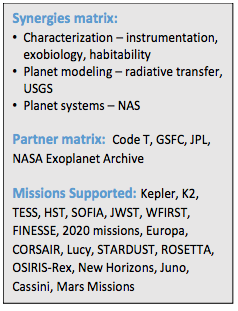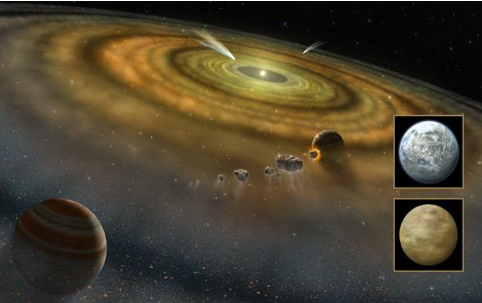Core Capability 2 – Origins & Evolution of Planetary Systems
Planetary Systems Highlights
Observations from Earth and space continue to demonstrate that planet formation is a poorly understood process leading to diverse outcomes, and that the protoplanetary disks in which planets form are both common and varied. Given the many future missions (e.g., SOFIA, ALMA, TESS, JWST, FINESSE, Origins, LUVOIR) focusing on star and planet formation, missions to satellites and primitive bodies (Europa, CORSAIR and Lucy), possible entry probe missions focusing on our own giant planets, and the importance of terrestrial planets to astrobiology, understanding the origins of planetary systems will always be a major focus of research at NASA.
The Division “Origins” group provides NASA and the community a unique interdisciplinary resource with a broad range of expertise and a long-term perspective on major outstanding problems not commonly found in academia. Ames is recognized as having the primary agency role in this crosscutting research capability (per NPD 1000.3E chapter 6.2 and APMC 2016-09-15). The team’s research covers the full range of planetary formation from the nebular gas and dust to the planets, satellites and surviving primitive bodies we see today, tying together the disciplines of astrophysics, exoplanetary and planetary science, and meteoritics.
During 2018, the Origins group began weekly group meetings to share our research, broaden our individual understanding, review ongoing developments in the field, and identify research gaps and emerging opportunities. As a result of these discussions we have identified several interdisciplinary tasks of wide community interest we plan to pursue in more depth.
One new focus area will be a detailed study of The First Million Years of protoplanetary nebula evolution. A lot happened in the first Myr of our own protoplanetary nebula. Meteoritic data reveals that planetesimals had already formed by 0.1Myr in the inner nebula, and 0.4Myr in the outer nebula. It also appears that the composition of these planetesimals changed dramatically within that timeframe, but not much subsequently. It is a popular idea that a Jupiter core formed in that general timeframe, separating these regions. Models and observations show that this period is a time of elevated stellar brightness, ongoing infall from the parent cloud, and outward-flowing disk winds. This critical period has, however, received little attention because of modeling and observational challenges. We believe the time is right for a dedicated focus on including all the relevant fluid dynamics and energetics self-consistently with particle growth, drift, planetesimal formation and core formation, with a close eye to observations. We plan to hold a workshop next year, attracting an interdisciplinary mix of community participants.
Objective 2.1 – Understand Evolution of Protoplanetary Nebulae
Infall from dense clouds of gas and dust leads to the formation of flattened, rotationally supported, disks in about 105 years. This nearly-Keplerian flow state follows a poorly understood, shorter stage in which infall, gravitational instabilities, disk fragmentation and episodic accretion may all be going on at once. These early processes have important long-term consequences for planet formation, including removal of angular momentum by jets or winds in the inner disk, intense radiation from young stars, and strong, turbulence driven disk expansion and mixing of thermally processed solids into the outer disk. Ionized and neutral gases both play important roles. Nebula gas turbulence, in particular, remains very poorly understood. These same processes describe exoplanet formation around single and binary stars.
Chaotic dynamics accounts for some of the diversity of exoplanetary systems, but most of it must arise from the diversity of their parent disks. To understand the chemical and physical structure of disks, we will build upon existing expertise and develop informed, global 3D disk models that simulate all the key processes relevant to planet formation. We will study basic transport processes in irradiated disks, the removal of material by thermal and MHD winds and outflows, and transport and mixing of chemical and isotopic species in the gas and solid phases. In collaboration with Code T and academic partners we will have a focus on the generation, intensity, and spatial-temporal distribution of turbulence in all stages of disk evolution, because of its critical importance to growth of objects from pebble to planetesimal size. Another focus on physical-chemical disk models will predict line and continuum emission from radio to optical/UV wavelengths, giving a connection to current (JWST, SOFIA) and future missions (LUVOIR, OST, SPICA). With the upcoming launch of JWST, the improved sensitivity of HIRMES on SOFIA, and the full ALMA array, there will soon be immense amounts of observational data requiring models and theory to interpret.
Objective 2.2 – Understand Particle Growth from Dust to Planetesimals
A main objective of our global nebula evolution models is to determine how condensibles (from silicates and higher-temperature condensates such as Calcium-Aluminum rich inclusions or CAIs, through H2O, to CO, CH4 and other highly volatile materials) are redistributed in the disk before being accreted into planetesimals. Our models capture state-of-the-art growth-by-sticking physics, in plausible turbulence, with all the associated diffusive mixing, radial drift, and opacity changes that then determine nebula temperature structure and the locations of condensation fronts for all these materials as functions of time. Ultimately these models will be applied to understand more subtle aspects of meteorite parent bodies such as their chemical and isotopic composition.
The size distribution, internal structure, and composition of the earliest planetesimals provides a critical initial condition to all models of subsequent stages of planetary accretion, and a tangible connection to today’s comets, asteroids, the meteorite record, and Ames’ lead role in Planetary Defense. Ames has been a leader in planetesimal formation by developing one of the two “leapfrog” models that avoid all the barriers to growth in turbulence, and this work continues as we incorporate subtle relative velocity effects in growth of chondrule aggregates that may now have been seen in primitive meteorites. The regimes of validity of candidate leapfrog mechanisms depend strongly on how large aggregates of solid particles can grow, in regions of different temperature, composition, and turbulent intensity, while drifting radially towards warmer areas where they can evaporate. The goal is to understand all the observations – initial mass functions of asteroids and KBOs, the conditions and timing of planetesimal formation, and the diverse properties of meteorite constituents. The team will explore how the diversity of outcomes depends on the diversity of nebula properties, determines the subsequent evolution of giant planet properties, and connects with the diversity of exoplanetary systems.
Objective 2.3 – Understand Formation of Planets, Satellites and Rings, and Their Long-Term Evolution and Dynamics
Modeling the late stages of terrestrial planet growth, including fragmentation in high-velocity impacts, is an astrobiological priority. The emphasis will be determining the flux of large impactors arriving late enough to severely perturb a biosphere, and quantifying the delivery of volatiles. Simulations will address both single stars with various giant planet configurations, and multiple star systems such as Alpha Centauri.
The Ames-led group has developed the most complete and comprehensive model of giant planet growth, capturing the most critical physics. The biggest question for the formation of warm/hot (sub-) Neptune planets that Kepler found in abundance, and TESS will locate around bright stars, is whether they accreted in situ, as suggested by their nearly circular orbits and paucity of strong resonances with their neighbors; or whether they formed at larger distances and then migrated to their current locations, which makes accretion and retention of their voluminous atmospheres much easier to understand. Several new modules will be integrated, and new physics added to address the new hypothesis that growing cores accrete mm-cm “pebble”-size objects even faster than the traditional 10- 100km size planetesimals. For giant planets, an important new question is how formation and evolution sculpted the gradual transition between core and envelope at Jupiter and Saturn implied by Juno and Cassini data. With Code T and academic collaborators, we will incorporate mixing of condensibles with H/He inside giant planets, and sophisticated models of atmospheric escape, while streamlining our codes, to address these issues.
Formation theories for satellite and ring systems of the giant planets are in their infancy. Most current models omit experimentally constrained models of dust aggregation and do not treat the circumplanetary (sub-)disk as a dynamically evolving medium with dynamical times 100x shorter than in the parent nebula. Additionally, there is a complex interplay between turbulence, sub-disk formation, cooling, and dispersal, and the mechanisms of solids delivery, determining which volatiles actually did condense out. Here we can synergistically apply all the work in Objective 2.2, on incremental growth and drift of solids, and “leapfrog” processes of planetesimal formation. Some large icy moons are apparently only partially differentiated (e.g., Callisto), while some small mid-size moons manage to be differentiated (e.g., Dione, Enceladus). Modeling their internal histories will support NASA’s new “Ocean Worlds” initiative, and gives the group a strong collaborative connection with the Planet Modeling, Atmospheres and Climate, and Landforms groups at Ames. We will also assess a promising new hypothesis that the Saturn ring-moon system underwent a catastrophic disruption scenario 100- 200 Myr ago.
Much of what we know of multiple-planet exosystems, in particular regarding the internal density of their planets, has been learned by detailed dynamical modeling of their interacting orbits. Determining how many planets can stably orbit within a star’s habitable zone is of fundamental value, is important to designing planet detection missions, and is also of importance to astrobiology. We will continue this work. Predictions will also be made about the expected architecture and composition of exomoon systems.
Objective 2.4 – Integration with NASA Science Missions and the Scientific Community
Ames’ Origin of Planetary Systems research has a long history of contributing to the success of NASA Planetary and Astrophysics missions and continue making this a cornerstone of our strategic planning. This interdisciplinary group, including cross-Division, other Codes at ARC and community members, will participate actively in design, development and execution of missions to primitive bodies, the moon, planets, satellites and rings, and exoplanet space observatories. We will apply our theory and model efforts to understand and leverage data from current missions including Hubble, Spitzer, and SOFIA (and ALMA) observations of circumstellar disks and Kepler / K2 / TESS observations of planetary system architectures.
Division scientists have also developed community-related capabilities for the JWST NIRCam and MIRI instruments and will be executing a guaranteed time observer program to study the photospheric properties of the youngest (Class 0) protostars and how they impact their forming planetary systems (JWST GTO program 1186). Division researchers are on the science and technology definition team of the Origins Space Telescope and LUVOIR Astro2020 Decadal Survey mission studies and will contribute to the scientific definition of other future space telescopes.
These connections will be formed and strengthened by holding organized, focused workshops on timely interdisciplinary subjects for the community, and continuing to train the next generations of theorists and observers via the highly successful NASA Postdoctoral Program and mentoring of graduate student researchers and student interns.

























